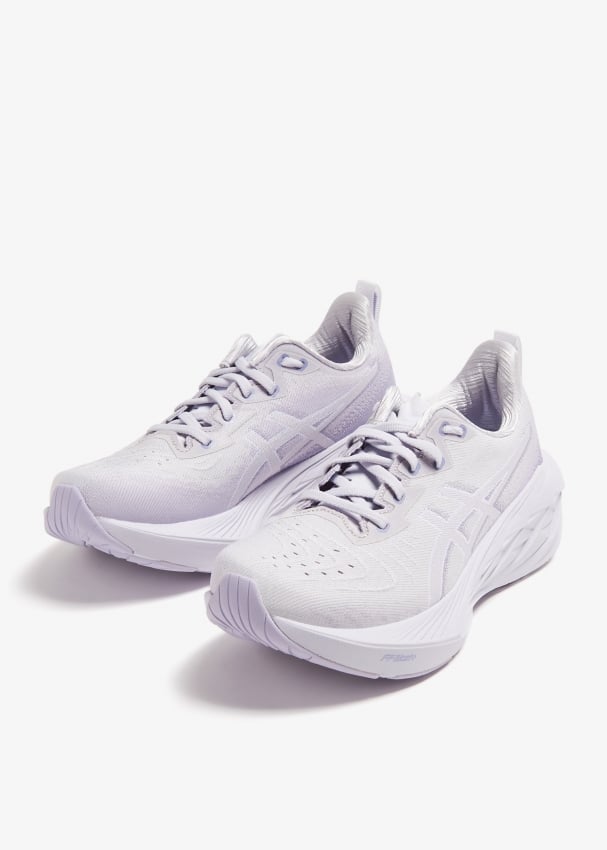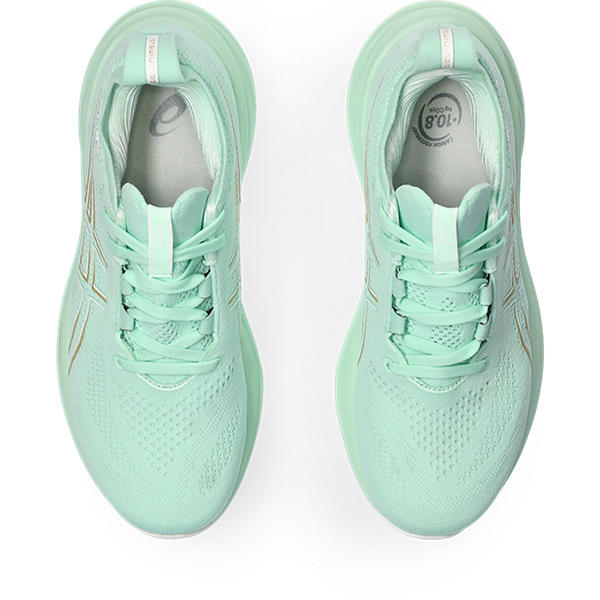![]()
 On the hunt for a new — or maybe even your first — pair of running shoes? Well, you’ve come to the right place. In 2024, footwear is lighter, more comfortable and faster than ever before, leading to PBs on race days, quicker recovery from hard workouts and more joy on easy runs. But finding the best running shoes for you can be challenging. There are plenty of factors to consider: your unique running style, your weight, the surface(s) you run on, the shape of your feet and your preferred ‘feel’.
On the hunt for a new — or maybe even your first — pair of running shoes? Well, you’ve come to the right place. In 2024, footwear is lighter, more comfortable and faster than ever before, leading to PBs on race days, quicker recovery from hard workouts and more joy on easy runs. But finding the best running shoes for you can be challenging. There are plenty of factors to consider: your unique running style, your weight, the surface(s) you run on, the shape of your feet and your preferred ‘feel’.
To make things easier, we’ve put together a complete guide to the best running shoes on the market in 2024 below. You’ll find shoes for easy runs, long runs and race day, as well as shoes geared towards specific individuals including beginners and overpronators. If you’re after something even more specific, we’ve also created guides to the best running shoes for wide feet and flat feet, too.
LIST OF PRODUCTS IN THE ARTICLE
Guide to Buying Running Shoes
Choosing the right running shoes is crucial for enhancing your performance and preventing injuries. Here’s a detailed guide to help you select the ideal pair of running shoes.
1. Determine the Right Type of Shoe
- Neutral Shoes: Suitable for runners with neutral feet or slight underpronation. They typically offer cushioning and flexibility.
- Stability Shoes: Ideal for runners with mild to moderate overpronation. They are designed with extra support in the midsole to maintain stability.
- Motion Control Shoes: Best for runners with severe overpronation. These shoes provide maximum support and control of movement.
2. Know Your Shoe Size
- Measure Your Feet: Measure your feet at the end of the day when they are at their largest. Ensure there is about a thumb’s width of space between your longest toe and the end of the shoe.
- Try Multiple Sizes: Sizes can vary between brands. Try on multiple sizes and choose the pair that feels the most comfortable.
3. Check the Fit
- Proper Fit: Shoes should be snug but not tight. Check that the heel holds your foot firmly and that there is enough room in the toe box for your toes to move freely.
- Test Run: If possible, take a short run in the store to gauge comfort and performance.
4. Consider Your Running Surface
- Road Running: Choose shoes with good cushioning and a flat sole to reduce shock and provide comfort on hard surfaces.
- Trail Running: Opt for shoes with rugged, slip-resistant soles and sturdy uppers to protect against rocks and debris.
5. Evaluate Durability and Quality
- Material Check: Choose shoes made from durable, lightweight, and breathable materials.
- Reputable Brands: Select from well-known brands with positive reviews from users and experts.
6. Special Features
- Cushioning Technology: Some shoes come with advanced cushioning technologies that help absorb shock and improve responsiveness.
- Support Design: Shoes with support designs for the arch, heel, and midfoot can help maintain proper running form.
7. Budget
- Price: More expensive shoes are not always the best. Consider your needs and choose a pair that fits your budget.
- Deals: Look for sales or discounts to get good quality shoes at a reasonable price.
Choosing the right running shoes not only enhances your running experience but also reduces the risk of injury. Take the time to try on and select the pair that best suits your needs and running style. Good luck in finding the perfect running shoes and happy running!
How often do you need to change your running shoes?
Mileage and time
The general rule of thumb is to replace your running shoes every 300-500 miles (480-800 km) or every 6-12 months, whichever comes first. However, this can vary depending on a few factors:
| Factor | Explanation |
|---|---|
| Your weight | Heavier runners tend to wear down shoes faster. |
| Terrain | Running on rougher surfaces like trails will wear down shoes quicker. |
| Your running style | Overpronators and those with a heavy heel strike tend to wear down the outer edge of the sole faster. |
Signs it’s time for new shoes
Here are some signs that it’s time to replace your running shoes:
- The midsole feels flat and compressed
- The outsole is worn down, especially in high-wear areas like the heel
- The upper is fraying or the shoe feels less supportive
If you notice any of these signs, it’s a good idea to start shopping for a new pair of shoes, even if you haven’t reached the 300-500 mile mark yet.
Extending the life of your shoes
There are a few things you can do to help your running shoes last longer:
- Rotate between multiple pairs of shoes
- Avoid using your shoes for non-running activities like yard work
- Store your shoes in a cool, dry place when not in use
- Consider getting your shoes resoled when the outsole starts to wear down
By following these tips, you can potentially get a bit more mileage out of your favorite pair of running shoes.
How do I know my foot type for running shoes?
Understanding foot types
Knowing your foot type is key to finding the right running shoes. There are three main foot types:
- Neutral/normal arch: This is the most common foot type. Neutral arches are generally considered the ideal foot type for running.
- Low arch/flat feet: Also known as overpronation, this foot type rolls inward excessively when walking or running.
- High arch: Also known as underpronation or supination, this foot type rolls outward excessively when walking or running.
Determining your foot type
There are a few ways to determine your foot type:
- Wet test: Wet your feet and step onto a flat surface like concrete or a paper bag. Look at the imprint – a neutral foot will leave a distinct curve on the inside of the foot, a flat foot will leave a full imprint, and a high-arched foot will leave a very narrow imprint.
- Visual inspection: Look at the arches of your feet. If they appear low or flat, you likely have low arches. If they appear very high, you likely have high arches.
- Gait analysis: Many running stores or specialty fitness stores offer gait analysis, where they’ll watch you walk or run on a treadmill to determine your foot type and pronation.
Once you know your foot type, you can start looking for running shoes that provide the right level of support and cushioning for your needs.
Choosing the right shoes
- Neutral/normal arch: Look for shoes labeled as “neutral” or “cushioned” that provide moderate support.
- Low arch/flat feet: Opt for shoes with added stability and motion control features to help control overpronation.
- High arch: Choose shoes with more flexible, responsive cushioning to accommodate your tendency to supinate.
Keep in mind that your foot type can change over time due to factors like age, weight, and injury. It’s a good idea to get re-evaluated periodically, especially if you notice changes in how your feet feel during or after runs.
Daily trainers
(Best Running Shoes)Asics Novablast 4

Overview: The Asics Novablast 4 is a daily training shoe that delivers a smooth, responsive ride. Featuring Asics’ FF Blast+ midsole foam, the Novablast 4 provides excellent energy return and cushioning.
Key features:
- Lightweight and breathable mesh upper
- FF Blast+ midsole for soft, bouncy cushioning
- Durable rubber outsole with strategically placed grip
- 10mm drop
Who it’s for: The Novablast 4 is a great option for daily training, long runs, and easy efforts. It’s suitable for neutral runners looking for a lively, well-cushioned shoe.
(Best Running Shoes)On Cloudeclipse

Overview: The On Cloudeclipse is a daily trainer that offers a unique, responsive ride. On’s signature CloudTec cushioning provides a soft, springy feel underfoot.
Key features:
- Breathable, lightweight mesh upper
- CloudTec midsole with Helion superfoam for cushioning and energy return
- Rubber grip on the outsole for traction
- 8mm drop
Who it’s for: The Cloudeclipse is a great option for neutral runners who want a shoe that’s comfortable for daily training but still feels lively and fast.
(Best Running Shoes)Nike Invincible 3

Overview: The Nike Invincible 3 is a maximally cushioned daily trainer that provides a soft, plush ride. Nike’s ZoomX foam delivers exceptional energy return and responsiveness.
Key features:
- Breathable, stretchy upper with reinforced overlays
- Thick ZoomX midsole for supreme cushioning
- Durable rubber outsole
- 9mm drop
Who it’s for: The Invincible 3 is ideal for runners looking for a super-soft, highly cushioned shoe for easy runs, recovery days, and long runs.
(Best Running Shoes)Nike Pegasus 40

Overview: The Nike Pegasus 40 is a versatile daily trainer that can handle a variety of runs. This latest iteration features an updated midsole for a smooth, responsive ride.
Key features:
- Engineered mesh upper for breathability and support
- React foam midsole for cushioning and energy return
- Durable rubber outsole with good traction
- 10mm drop
Who it’s for: The Pegasus 40 is a great all-around shoe suitable for neutral runners of all abilities, from beginners to experienced marathoners.
(Best Running Shoes)Adidas Supernova Rise

Overview: The Adidas Supernova Rise is a daily trainer that provides a comfortable, well-cushioned ride. Adidas’ Boost midsole foam delivers a responsive, bouncy feel.
Key features:
- Breathable mesh upper with supportive overlays
- Boost midsole for soft, springy cushioning
- Continental rubber outsole for traction
- 10mm drop
Who it’s for: The Supernova Rise is a good option for neutral runners who want a well-cushioned, versatile shoe for daily training and long runs.
(Best Running Shoes)Saucony Ride 17

Overview: The Saucony Ride 17 is a reliable daily trainer that offers a smooth, balanced ride. Saucony’s PWRRUN cushioning provides a responsive, well-cushioned feel.
Key features:
- Breathable mesh upper with supportive overlays
- PWRRUN midsole for cushioning and energy return
- Durable rubber outsole with good traction
- 8mm drop
Who it’s for: The Ride 17 is a great all-around shoe suitable for neutral runners of all abilities, from beginners to experienced marathoners.
(Best Running Shoes)Puma Magnify Nitro 2

Overview: The Puma Magnify Nitro 2 is a daily trainer that delivers a responsive, energetic ride. Puma’s NITRO+ midsole foam provides excellent cushioning and bounce.
Key features:
- Lightweight, breathable mesh upper
- NITRO+ midsole for cushioning and energy return
- Durable rubber outsole with good traction
- 10mm drop
Who it’s for: The Magnify Nitro 2 is a great option for neutral runners looking for a daily trainer that feels lively and springy underfoot.
(Best Running Shoes)Asics Gel-Nimbus 26

Overview: The Asics Gel-Nimbus 26 is a well-cushioned daily trainer that provides a smooth, comfortable ride. Asics’ Gel technology and FF Blast+ midsole offer excellent shock absorption and energy return.
Key features:
- Breathable mesh upper with supportive overlays
- Gel technology and FF Blast+ midsole for cushioning
- Durable rubber outsole with good grip
- 10mm drop
Who it’s for: The Gel-Nimbus 26 is a great choice for neutral runners who want a high-mileage daily trainer with plenty of cushioning and support.
Here’s how we tested the Running Shoes of 2024
1. Initial Assessment
- Design and Aesthetics: We examine the shoes’ design, color options, and overall aesthetics.
- Build Quality: We inspect the materials used and the construction quality, looking for any defects or weak points.
2. Comfort and Fit
- Sizing: We ensure the shoes fit true to size and evaluate their comfort for different foot shapes.
- Insole Support: We assess the arch support, cushioning, and overall feel of the insole.
- Upper Comfort: We check the flexibility, breathability, and softness of the shoe’s upper material.
3. Performance Testing
- Running Conditions: We test the shoes in various conditions, including road running, trail running, and treadmill running.
- Distance: We assess performance over different distances, from short sprints to long-distance runs.
- Speed: We evaluate how well the shoes support high-speed running versus a steady pace.
- Traction: We test the grip on different surfaces like asphalt, gravel, and wet paths.
4. Durability
- Wear and Tear: We conduct long-term wear tests to see how the shoes hold up after extended use.
- Sole Durability: We assess the wear on the outsole and the shoe’s overall structural integrity over time.
5. Breathability and Weather Resistance
- Ventilation: We measure how well the shoes manage heat and moisture build-up inside.
- Water Resistance: We test their performance in wet conditions and their ability to keep feet dry.
6. Cushioning and Shock Absorption
- Impact Testing: We analyze how well the shoes absorb shocks and reduce impact on joints during runs.
- Energy Return: We evaluate the responsiveness and energy return of the midsole.
7. Flexibility and Stability
- Flex Test: We check the flexibility of the sole and upper to ensure natural foot movement.
- Support: We assess the stability features, such as heel counters and side support, to prevent injuries.
8. Special Features
- Technology Integration: We evaluate any integrated technologies like smart sensors or advanced lacing systems.
- Customization: We look at features that allow for personalized adjustments, such as removable insoles or adjustable laces.
9. User Feedback
- Runner Reviews: We gather feedback from a diverse group of runners with different skill levels and running habits.
- Comfort Over Time: We collect data on how the comfort and performance of the shoes change over time with regular use.
After thorough testing across these various parameters, we compile our findings to determine the best running shoes of 2024. Our comprehensive testing ensures that the shoes we recommend offer the best combination of performance, comfort, and durability for runners of all types.
LIST OF PRODUCTS IN THE ARTICLE
Frequently Asked Questions (FAQs) and Answers When Buying Running Shoes
1. What type of running shoe is best for me?
Answer: The best type of running shoe for you depends on several factors, including your running style, the surface you run on, and any specific foot characteristics (such as arch type or pronation). Generally, running shoes are categorized into neutral, stability, and motion control. Visiting a specialty running store for a gait analysis can help determine the best shoe for your needs.
2. How should running shoes fit?
Answer: Running shoes should fit snugly but not too tight. There should be about a thumb’s width of space between your longest toe and the end of the shoe. The shoes should hold your heel in place without slipping and provide enough room in the toe box to allow your toes to wiggle.
3. How often should I replace my running shoes?
Answer: Most running shoes should be replaced every 300 to 500 miles, depending on the type of shoe, your running style, and the surfaces you run on. Signs that it’s time to replace your shoes include noticeable wear on the outsole, reduced cushioning, and new aches or pains after running.
4. Can I use running shoes for other sports or activities?
Answer: While running shoes are designed specifically for running, they can be used for other low-impact activities like walking or gym workouts. However, for sports that involve lateral movements, such as tennis or basketball, it’s better to use sport-specific shoes to prevent injuries.
5. What are the differences between road running shoes and trail running shoes?
Answer: Road running shoes are designed for pavement and have a smoother, lighter sole for speed and cushioning. Trail running shoes have a more rugged sole for better grip on uneven terrain, added protection against rocks and debris, and often include features like water resistance or reinforced toes.
6. Do I need to break in my running shoes?
Answer: Modern running shoes typically require minimal break-in time. You should feel comfortable running in them right out of the box, though a few short runs can help your feet adjust to the new shoes.
7. What are the benefits of different cushioning types (e.g., minimal, maximal)?
Answer: Minimal cushioning shoes provide a more natural running feel and can improve foot strength and proprioception. Maximal cushioning shoes offer more shock absorption and comfort, which can be beneficial for long-distance running or for runners with joint issues.
8. Are expensive running shoes always better?
Answer: Not necessarily. The best running shoes for you depend on your individual needs, not the price. Expensive shoes often feature the latest technology and materials, but many mid-range shoes offer excellent performance and comfort as well.
9. What is pronation, and why does it matter?
Answer: Pronation refers to the natural inward roll of the foot after landing. Overpronation (excessive inward roll) and underpronation (insufficient inward roll) can affect running efficiency and lead to injuries. Choosing shoes designed for your pronation type can help maintain proper alignment and reduce injury risk.
10. Can I wash my running shoes?
Answer: Yes, but it’s best to avoid using a washing machine. Remove the insoles and laces, then wash the shoes by hand using mild soap and water. Air dry them away from direct heat to prevent damage.
Having the right answers to these common questions can help you make an informed decision when buying running shoes, ensuring you find a pair that meets your needs and enhances your running experience.








